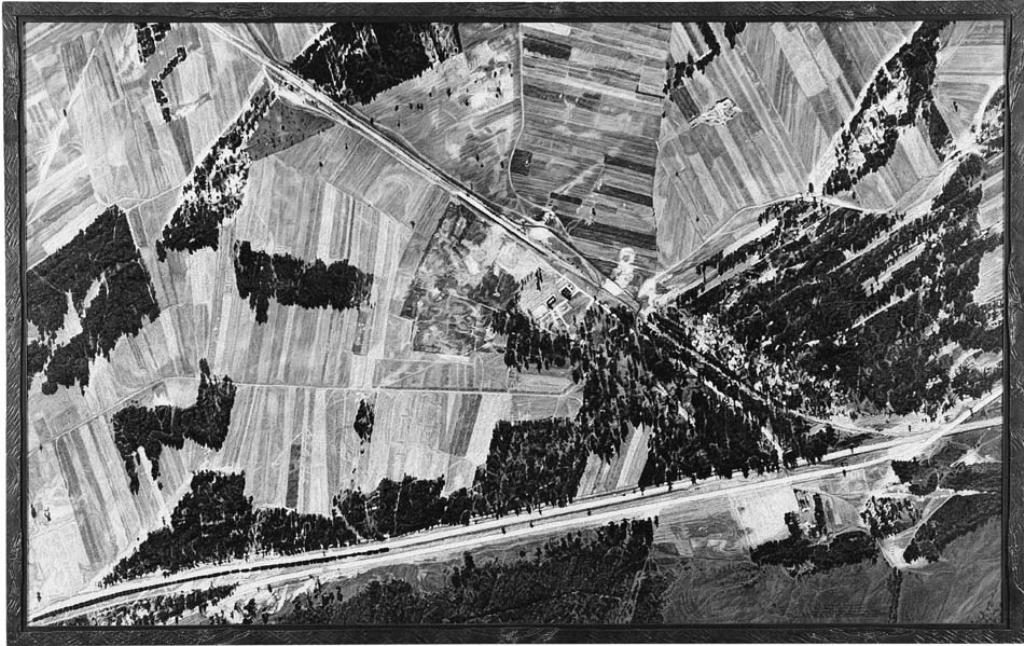
Arie A. Galles’ (1944-) Fourteen Stations drawings take a radical departure from the customary representations of Christ’s Passion stations. Traditionally, viewers meditate upon a series of works that trace Christ’s physical and mental agony from condemnation through to resurrection. I would like this post to open a dialogue into how unorthodox approaches to the Passion can deepen our understanding of people, place, suffering and healing.

Galles’ painstakingly mimicked aerial photographs of Nazi concentration camps based on Luftwaffe and Allied reconnaissance film. The meticulous drawings reproduce the mechanical photographs in incredible detail; the stations that were to be the final stations of millions of transported prisoners. There are four theological themes in this work I would like to contemplate.
Firstly is the theme of Kaddish; the Jewish burial prayer exalting God and yearning for the establishment of his Kingdom which is embedded in Hebrew and Aramaic through the series. Galles himself confesses, “The most sincere and honest way I know how to pray is through my work, So many people died in these camps, and there’s no one to say Kaddish for them.” In this we find a paradox; how can these depictions of the some of the cruelest and most heinous places in history come together to glorify the seemingly all-too-quiet God? The burial prayer reads, “May there be abundant peace from Heaven, and life upon us and upon all Israel”. The charcoal sketches proclaim a sense of immovable hope in death; quite characteristic of the historical Jewish faith, and the hope in the cross; possibly an aesthetic theodicy?
The most similar Biblical source to this enacted/embodied Kaddish would be book of Lamentations, traditionally ascribed to the prophet Jeremiah. The dirges and final psalm in the book are exemplars testifying to the marriage of craft and passion; of spontaneity and preparation. In both the Fourteen Stations and Lamentations, the laborious process involved in the works’ creation only intensifies the emotional turmoil portrayed. The artist-mourner writes, that the project “has been the most intense endeavor I have ever undertaken”.
Identification is also big theme in this work. It is most notable that some of the artist’s relatives died in Belzec, one of the camps drawn. The artist identifies the suffering and attempted annihilation of the Jewish people of last century with the crucifixion of Christ almost two thousand years ago. Is this to be read as a theological or simply art-historical theme?
The suffering of Jewish people today is therefore not isolated from the Jewish and Christian biblical accounts, and subsequently our minds are drawn to the Assyrian and Babylonian deportations, and the similar atrocities the people have survived. The ground of Jerusalem on which Christ (and many other patriarchs) suffered, the lost homeland, is somehow identified with these horrific places of utter desolation.
Finally, it is interesting that Galles spoke of a particular feeling of objectivity. Galles says he experienced the feeling of being “strapped to the belly of a bomber, looking down.” The aerial, God’s-eye view portrays an apparent scientific objectivity through which the viewer can leave with a haunting feeling of corporate responsibility. The atrocities are evident, and the passion is factual. The height and dislocation of both the photographic method and the birds-eye geographic view stand in tension with the intensely intimate reality of both the creative method and the on-the-ground systematic massacre.
Galles’ alternative stations come together in the creation of a distinct Passion narrative, one that prays, laments, identifies, and objectively condemns an irrefutable yet unthinkable period of recent history.
